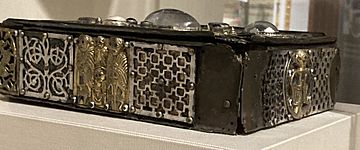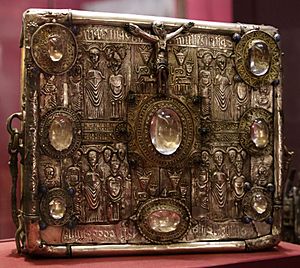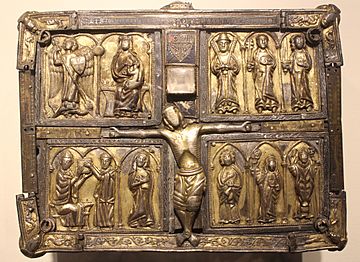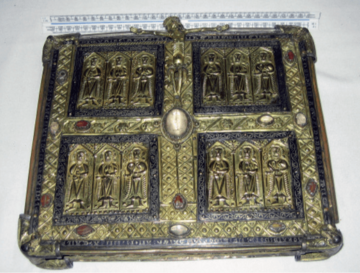Cumdach facts for kids
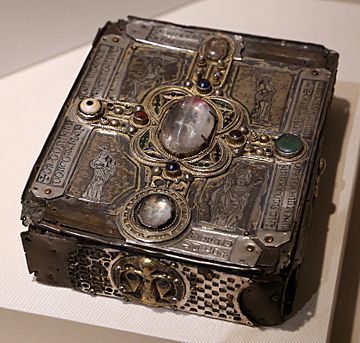
A cumdach (pronounced "KOOM-dakh") is an old Irish word for "cover." It refers to a fancy metal box or case. These special cases were used to hold important relics or ancient Irish books from the Early Middle Ages.
Most cumdachs are much newer than the books they protect. For example, many books inside them are from before the year 800. But the cumdachs themselves often date from after the year 1000. Most of these amazing objects come from Ireland. Today, you can see many of them at the National Museum of Ireland.
Cumdachs usually have a cross design on the front. They are decorated with large, shiny rock crystals or other semi-precious stones. The spaces around the cross are filled with detailed patterns. Some cumdachs were carried on a metal chain or leather cord. People often wore them around their neck or from their belt. This placed the cumdach near their heart. People believed this offered spiritual or even healing benefits. They were also used to help the sick or to make important agreements. Many cumdachs were passed down through families who had connections to monasteries.
Only a few early cumdachs still exist today. These include the cases for the Book of Dimma and the Book of Mulling. You can find these at Trinity College Dublin. Others are the Cathach of St. Columba and the Stowe Missal. Sometimes, the book inside is lost, but the cumdach remains. Other famous books, like the Book of Kells, once had cumdachs too. However, these were often stolen because they contained valuable metals.
Contents
What are Cumdachs Like?
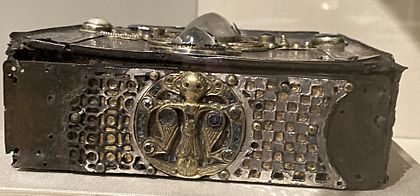
The idea for cumdachs might have come from book boxes used by early Christians in Rome. Both types of boxes were made to protect sacred texts or relics. Irish monasteries likely wanted to copy the impressive style of Roman church ceremonies.
The Irish church valued relics that were objects used by saints. This was different from other churches that preferred body parts. However, Irish churches also kept body parts in house-shaped boxes called chasses. Another special Irish item was the bell-shrine. These cases held hand bells used to call people to church services. One very old reliquary held a saint's belt. It was probably worn to test if someone was telling the truth or to cure illness. This belt dates back to the 8th century. It was found in a peat bog near Moylough, County Sligo.
Only about 8 to 10 cumdachs have survived. Many more were probably lost, often stolen for their precious metals or stones. These surviving cumdachs are sealed metal cases. They were built to protect older holy objects. Inside, they usually have a core made of yew wood or oak. Important church leaders often ordered these later updates. Skilled metalworkers and their teams did the work. Many master metalworkers even signed and dated their creations. Some of these signatures hint at why they made these beautiful pieces.
All existing cumdachs have a front cover with a central cross. The back often has repeating openwork patterns in two strong colors, like red and black. Their sides show interlace patterns and writings. Cumdachs come in different sizes. Some were small "pocket books" for private use. Others were larger and worn over the shoulder or from belts. The Shrine of Miosach still has its original chain for carrying it. The Soiscél Molaisse and Lough Kinsalen Shrine had fittings for leather straps. These straps likely held them in place during church parades.
Cumdachs are different from treasure bindings. Treasure bindings were metal covers attached to regular book bindings. The designs, however, might have been very similar. For example, the lower cover of the Lindau Gospels (around 880 AD) has a large cross. It is surrounded by interlace panels, much like a cumdach.
Who Made and Ordered Them?
Historians usually know who ordered these shrines. But almost nothing is known about the metalworkers who created them. Some cumdachs have signatures, but that's all we know. Craftsmen back then were not usually mentioned in history books. Many of them could not read or write. Some signatures are hard to understand. This might be because the person writing them didn't fully understand Latin.
What Were Cumdachs Used For?
Cumdachs had several uses. They protected old manuscripts or relics. They also served as portable centers for prayer. Many held manuscripts that were centuries old. People believed these books were written by famous saints. Because of this, many very old manuscripts survived only because they became holy relics. Other early Irish manuscripts were lost over time due to theft or plunder.
The shrines were used in both church and everyday ceremonies. They were used when giving someone an important job. They were also used when people swore oaths or signed agreements. The books of Dimma and Mulling were found with texts for masses for the dead. This suggests they were used for healing. The Book of Durrow was sometimes taken out of its cumdach. This was done to bless and cure sick animals.
Battle Standards
Reliquaries were often used as battle standards in medieval Ireland. People believed they would make soldiers brave and help them win. These relics were often held in cumdachs, crosiers, or bell-shrines. A cleric (a church official) would carry them onto the battlefield. This cleric was often a "hereditary custodian" for a powerful family.
The most famous cumdach used in battle is the Cathach of St. Columba. It was a battle charm for the O'Donnell family. It was thought to scare enemies and give confidence to the O'Donnell army. The objects were usually worn around the neck. The person carrying it would walk around the area three times before the battle. Other cumdachs used in this way include the Shrine of Miosach.
Clerics were not fighters, so they were less likely to be captured. Younger clerics were often chosen to carry these items. This was because they could run faster if things got dangerous. However, sometimes the carrier was killed. In 1497, the Cathach was captured after its keeper died. The Book of Armagh was also carried into battles. It was once found under the body of its dead custodian.
Surviving Cumdachs
Cumdachs are special to Ireland. There are eight known Irish examples that still exist. They include the Lough Kinale Book-Shrine, Soiscél Molaisse, Stowe Missal, The Cathach, Shrine of Miosach, Book of Dimma, Shrine of the Book of Moling, and Shrine of Caillín of Fenagh. There are also two "house-shaped shrines." These are St Manchan's shrine and the Domnach Airgid. All these objects were made to permanently seal and protect a manuscript or relic. They date from the early 9th to the mid-16th centuries.
Several early cumdachs are now lost. The Book of Durrow had a metal case from around 1002–1015. The Book of Kells lost its cumdach when it was stolen in 1006. The Book of Armagh got a cover in 937. This might have been lost when it was captured in battle. The earliest known cumdach was made for the Book of Durrow. It was ordered by the High King of Ireland Flann Sinna (877–916). Once a book was in its shrine, it was rarely, if ever, taken out to be read.
Lough Kinale Book Shrine
The oldest known cumdach is also the largest one that still exists. It dates from the late 8th or early 9th century. It was found in 1986 by divers in Lough Kinale in County Longford. It might have been thrown into the water to hide it from a local fight or a Viking raid. The inside is made of oak. It is covered with tin and bronze plates held by nails. The front has a large central cross. It also has five bronze bosses (raised bumps). There are four round openwork medallions with spiral and lentoid patterns. The sides show animal heads. In 2016, this object was valued at about £2 million (€2.54 million).
Soiscél Molaisse
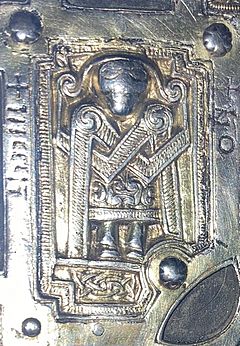
The Soiscél Molaisse is the oldest cumdach that is mostly in its original form. It was made in the early 11th century. It held the gospels of Molaise. It is about 14.75 cm high, 11.70 cm wide, and 8.45 cm thick. It was built in three stages. The wooden core with bronze casing is from the 8th century. Silver plates were added in the 11th century. It was worked on again in the 14th or 15th century.
Some parts, like figures, were added in the 14th century. The top is mostly silvered bronze and silver-gilt. It has panels with the four symbols of the Evangelists around a cross. Some panels are missing. The ones that remain have gold filigree (delicate wire work) with knotwork. The ends of the cross arms once held gems, but only one blue stone is left. Its small size suggests it was a portable "pocket book."
Stowe Missal
The Stowe Missal is a prayer book from about 750 AD. Its cumdach has metal plates attached to an older oak box. The metalwork is richly decorated with animal and human figures. One side and the edges probably date from 1027 to 1033. This is known from inscriptions. The other side is newer, from about 1375, also based on its inscriptions.
The older "lower" side is made of silver-gilt copper alloy. It has a large cross with an Irish inscription around its border and on the cross arms. The center of the cross was later changed. It now holds a space for a missing large stone. The inscription is missing parts because of this change. However, it can mostly be put back together. It asks for a prayer for the abbot of Lorrha and for the king of Múscraige Tíre.
Cathach of St. Columba

The Cathach of St. Columba is perhaps the most famous cumdach. It was made for the Cathach of St. Columba. This is an important psalter (book of psalms) from just after 597 AD. It is probably the oldest Irish book that still exists. The manuscript belonged to the O'Donnell family. Its shrine was famously used as a battle standard.
The first metalwork was added between 1072 and 1098. This was a new protective case of wood and silver. The front cover was added in the 14th century. It shows a large seated Christ in Majesty. Scenes of the Crucifixion and saints are also shown in gilt repoussé (raised metalwork). It was taken to Europe in 1691. It did not return to Ireland until 1813. That year, the cumdach was opened. This led to the rediscovery of the manuscript. It was in very bad shape. But it was greatly restored in 1982.
Shrine of Miosach
The Shrine of Miosach comes from Clonmany, County Donegal. It was also used in battle. It was originally a relic from the late 11th century. It was updated in 1534 by a goldsmith named Brian O'Morrison. He added silver decoration with many figures around a cross. O'Morrison added twelve front plates. These include images of the crowned Virgin and Child. They also show Saint Bridget, St. Patrick, and Colm Cille.
We don't know what the original container held. The object was first linked to St Cairneach. But by the Gothic period, it was connected to St Columba. The 11th-century cast copper alloy plates on the sides have openwork animal pictures. Its metal cord for carrying it still exists. It was probably worn around the neck.
Domnach Airgid
The Domnach Airgid means "Silver church" in English. Its original parts date to the 8th century. But most of what we see is from major additions around 1350. These were ordered by the abbot of Clones. A three-dimensional figure of Christ on the cross is in the center of the main face. It is joined by relief plaques of saints, the Virgin and Child, and other scenes on the sides.
The reliefs are more detailed than other 14th-century cumdachs. They have elegant running animals at the corners. It is signed by its goldsmith, John O Bardan. By this time, goldsmiths in Ireland were usually not church officials.
Book of Dimma
The Book of Dimma cumdach is from the 12th century. It was made for the small 8th-century manuscript called the Book of Dimma. This manuscript is linked to the abbey's founder, St Crónán (died 619). Its small size means it was meant to be a portable pocket book. It contains copies of four Gospels. It also has stylized pictures of the Apostles St. Matthew, St. Mark, and St. Luke.
The shrine is made of decorated bronze plates. Like the manuscript, it comes from the abbey of Roscrea. The first part of the cumdach was finished during a good time for the abbey. This was around when a Romanesque church was built there. It was updated around 1400 by a local chieftain's family. One side of the cumdach has openwork decoration in the Viking Ringerike style. The cumdach and manuscript are at Trinity College Dublin. A copy from the early 20th century is in New York.
Shrine of Caillín of Fenagh
The Shrine of Caillín of Fenagh is a later example. It was built to hold a manuscript from around 1516. This manuscript updated a much older book about the life of St. Caillín of Fenagh, County Leitrim (lived around 570 AD). Caillín was known for making battle charms. Legend says he ordered several battle standards. These included bell-shaped objects and containers for a Gospel. The cumdach was badly damaged in a 2009 fire at St Mel's Cathedral, Longford. It was bought by the NMI the next year. The manuscript is at the Royal Irish Academy. There is some question if this shrine was truly meant to be a cumdach. One reason is that it is smaller than the manuscript it was supposed to hold.
Studying and Protecting Cumdachs
Most of these book-shaped shrines are mentioned in old Irish records. But they were not properly described until the early 19th century. That's when people like George Petrie started looking for them. Most cumdachs are badly damaged. This is due to normal wear and tear, fires, or because their valuable parts, like gemstones, were removed and sold. Most of them are now in the National Museum of Ireland.
The most important lost cumdachs are mentioned in Irish records. These include the shrines for the Book of Armagh (added 938 AD) and the Book of Durrow (around 877–91 AD). The shrine for the Book of Kells was stolen in 1007. It might have been just a decorative metal container, not a sealed cover.
|




